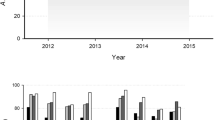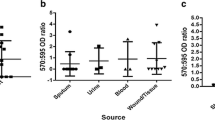Abstract
The prevalence of carbapenem-resistant Acinetobacter baumannii in Saudi Arabia and their resistance genetic mechanisms are yet to be identified. We studied the prevalence and genetic diversity of extended-spectrum beta-lactamase genes, particularly the PER-1 gene, among carbapenem-resistant A. baumannii strains from patients at a tertiary care hospital in Riyadh, Saudi Arabia between 2006 and 2014. Fresh subcultured samples were tested for antimicrobial susceptibility minimum inhibitory concentration (MIC). Total genomic DNA was extracted from each isolate and further used for polymerase chain reaction (PCR) genotyping, sequence-based typing (SBT) of PER-1 and OXA-51-like gene, and multilocus sequence typing (MLST) of positive isolates. Randomly selected clinical isolates (n = 100) were subjected to MLST. A total of 503 isolates were characterized as multidrug-resistant (MDR) using the MIC. Isolates were further PCR tested for bla -TEM and bla -PER-1 resistance genes (n = 503). The genotyping results showed that 68/503 (14 %) isolates were positive to bla TEM. The genotyping results of PER-1-like genes showed that 384/503 (76.3 %) were positive among MDR Acinetobacter isolates. Based on SBT, the majority of these isolates were clustered into three main groups including isolates harboring PER-1: AB11 (bla -PER-1), isolate AB16 (bla -PER-1), and, finally, the plasmid pAB154 (bla -PER-7). Remarkably, many isolates were concealing the PER-1 gene and harboring the TEM resistance genes as well. MLST results for selected isolates (n = 100) identified four main sequence types (STs: 2, 19, 20, and 25) and four novel isolates (ST 486–489). We report 76.3 % prevalence of the PER-1 resistance gene among Acinetobacter clinical isolates from Riyadh, Saudi Arabia. Further work is needed to explore the clinical risks and patient outcome with such resistance related to healthcare-associated infections and investigate the genetic and molecular mechanisms that confer the MDR phenotype.

Similar content being viewed by others
References
Al Johani SM, Akhter J, Balkhy H et al (2010) Prevalence of antimicrobial resistance among gram-negative isolates in an adult intensive care unit at a tertiary care center in Saudi Arabia. Ann Saudi Med 30(5):364–369
Aly M, Balkhy HH (2012) The prevalence of antimicrobial resistance in clinical isolates from Gulf Corporation Council countries. Antimicrob Resist Infect Control 1(1):26
Aly M, Tayeb HT, Al Johani SM et al (2014) Genetic diversity of OXA-51-like genes among multidrug-resistant Acinetobacter baumannii in Riyadh, Saudi Arabia. Eur J Clin Microbiol Infect Dis 33(7):1223–1228
Peleg AY, Seifert H, Paterson DL (2008) Acinetobacter baumannii: emergence of a successful pathogen. Clin Microbiol Rev 21(3):538–582
Poirel L, Marqué S, Héritier C et al (2005) OXA-58, a novel class D {beta}-lactamase involved in resistance to carbapenems in Acinetobacter baumannii. Antimicrob Agents Chemother 49(1):202–208
Mussi MA, Limansky AS, Viale AM (2005) Acquisition of resistance to carbapenems in multidrug-resistant clinical strains of Acinetobacter baumannii: natural insertional inactivation of a gene encoding a member of a novel family of {beta}-barrel outer membrane proteins. Antimicrob Agents Chemother 49(4):1432–1440
Bae IK, Jang SJ, Kim J et al (2011) Interspecies dissemination of the bla gene encoding PER-1 extended-spectrum beta-lactamase. Antimicrob Agents Chemother 55(3):1305–1307
Vahaboglu H, Coskunkan F, Tansel O et al (2001) Clinical importance of extended-spectrum beta-lactamase (PER-1-type)-producing Acinetobacter spp. and Pseudomonas aeruginosa strains. J Med Microbiol 50(7):642–645
Vahaboglu H, Saribaş S, Akbal H et al (1998) Activities of cefepime and five other antibiotics against nosocomial PER-1-type and/or OXA-10-type beta-lactamase-producing Pseudmonas aeruginosa and Acinetobacter spp. J Antimicrob Chemother 42(2):269–270
Pasterán F, Rapoport M, Petroni A et al (2006) Emergence of PER-2 and VEB-1a in Acinetobacter baumannii strains in the Americas. Antimicrob Agents Chemother 50(9):3222–3224
Hu WS, Yao SM, Fung CP et al (2007) An OXA-66/OXA-51-like carbapenemase and possibly an efflux pump are associated with resistance to imipenem in Acinetobacter baumannii. Antimicrob Agents Chemother 51(11):3844–3852
Chen TL, Chang WC, Kuo SC et al (2010) Contribution of a plasmid-borne blaOXA-58 gene with its hybrid promoter provided by IS1006 and an ISAba3-like element to beta-lactam resistance in Acinetobacter genomic species 13TU. Antimicrob Agents Chemother 54(8):3107–3112
Vahaboglu H, Oztürk R, Aygün G et al (1997) Widespread detection of PER-1-type extended-spectrum beta-lactamases among nosocomial Acinetobacter and Pseudomonas aeruginosa isolates in Turkey: a nationwide multicenter study. Antimicrob Agents Chemother 41(10):2265–2269
Culebras E, González-Romo F, Head J et al (2010) Outbreak of Acinetobacter baumannii producing OXA-66 in a Spanish hospital: epidemiology and study of patient movements. Microb Drug Resist 16(4):309–315
Giannouli M, Cuccurullo S, Crivaro V et al (2010) Molecular epidemiology of multidrug-resistant Acinetobacter baumannii in a tertiary care hospital in Naples, Italy, shows the emergence of a novel epidemic clone. J Clin Microbiol 48(4):1223–1230
Gogou V, Pournaras S, Giannouli M et al (2011) Evolution of multidrug-resistant Acinetobacter baumannii clonal lineages: a 10 year study in Greece (2000–09). J Antimicrob Chemother 66(12):2767–2772
Evans BA, Hamouda A, Towner KJ et al (2010) Novel genetic context of multiple bla OXA-58 genes in Acinetobacter genospecies 3. J Antimicrob Chemother 65(8):1586–1588
Rawat D, Nair D (2010) Extended-spectrum beta-lactamases in Gram negative bacteria. J Glob Infect Dis 2(3):263–274
Diancourt L, Passet V, Nemec A et al (2010) The population structure of Acinetobacter baumannii: expanding multiresistant clones from an ancestral susceptible genetic pool. PLoS One 5(4):e10034
Bacila I, Jakab E, Ferencz B et al (2008) MLST method (Multilocus Sequence Typing). Bacteriol Virusol Parazitol Epidemiol 53(1):13–17
Hujer KM, Hujer AM, Hulten EA et al (2006) Analysis of antibiotic resistance genes in multidrug-resistant Acinetobacter sp. Isolates from military and civilian patients treated at the Walter Reed Army Medical Center. Antimicrob Agents Chemother 50(12):4114–4123
Mugnier PD, Bindayna KM, Poirel L et al (2009) Diversity of plasmid-mediated carbapenem-hydrolysing oxacillinases among carbapenem-resistant Acinetobacter baumannii isolates from Kingdom of Bahrain. J Antimicrob Chemother 63(5):1071–1073
Opazo A, Vali L, Al Obaid K et al (2014) Novel genetic structure harbouring blaPER-1 in ceftazidime-resistant Acinetobacter baumannii isolated from Kuwait. Int J Antimicrob Agents 43(4):383–384
Khan FY, Abukhattab M, Baager K (2012) Nosocomial postneurosurgical Acinetobacter baumannii meningitis: a retrospective study of six cases admitted to Hamad general hospital, Qatar. J Hosp Infect 80(2):176–179
Opazo A, Sonnevend A, Lopes B et al (2012) Plasmid-encoded PER-7 beta-lactamase responsible for ceftazidime resistance in Acinetobacter baumannii isolated in the United Arab Emirates. J Antimicrob Chemother 67(7):1619–1622
Lakshmana Gowda K, Marie MA, Al-Sheikh YA et al (2014) A 6-year surveillance of antimicrobial resistance patterns of Acinetobacter baumannii bacteremia isolates from a tertiary care hospital in Saudi Arabia during 2005–2010. Libyan J Med 9:24039
Wang H, Guo P, Sun H et al (2007) Molecular epidemiology of clinical isolates of carbapenem-resistant Acinetobacter spp. from Chinese hospitals. Antimicrob Agents Chemother 51:4022–4028
Giordano A, Varesi P, Bertini A et al (2007) Outbreak of Acinetobacter baumannii producing the carbapenem-hydrolyzing oxacillinase OXA-58 in Rome, Italy. Microb Drug Resist 13:37–43
Opazo A, Sonnevend A, Lopes B et al (2012) Plasmid-encoded PER-7 β-lactamase responsible for ceftazidime resistance in Acinetobacter baumannii isolated in the United Arab Emirates. J Antimicrob Chemother 67(7):1619–1622
Author information
Authors and Affiliations
Corresponding author
Ethics declarations
Funding
This work has been supported by a grant from King Abdulaziz City for Science and Technology (KACST), Riyadh, Saudi Arabia, grant number ARP-28-112.
Conflict of interest
All authors confirm that there is no conflict of interest or financial relationship with the organization that funded the research.
Ethics statement
Ethical approval and consent were not required for this study because no human or animal subjects were used.
Rights and permissions
About this article
Cite this article
Aly, M.M., Abu Alsoud, N.M., Elrobh, M.S. et al. High prevalence of the PER-1 gene among carbapenem-resistant Acinetobacter baumannii in Riyadh, Saudi Arabia. Eur J Clin Microbiol Infect Dis 35, 1759–1766 (2016). https://doi.org/10.1007/s10096-016-2723-8
Received:
Accepted:
Published:
Issue Date:
DOI: https://doi.org/10.1007/s10096-016-2723-8




